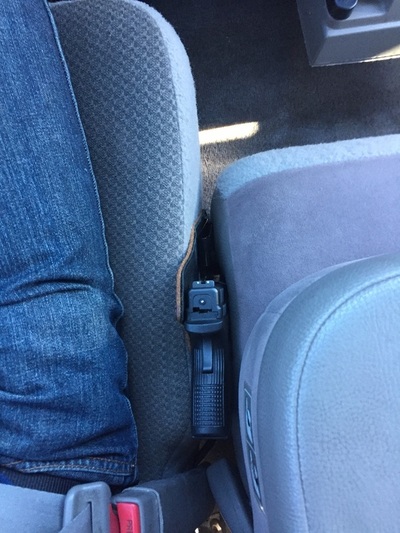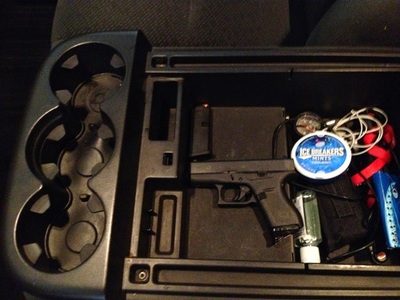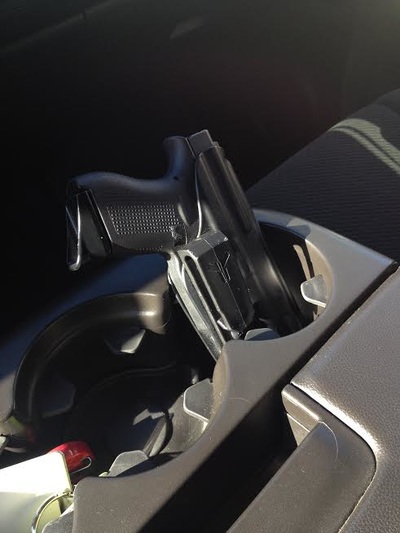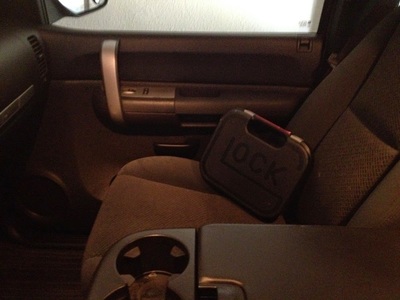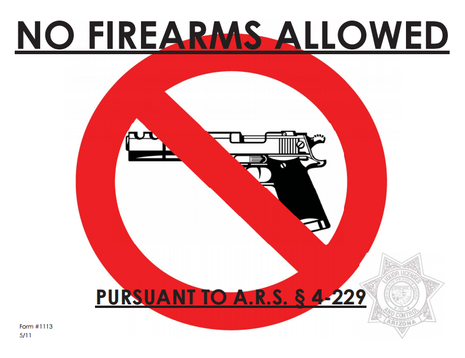Open Carry
The open carry of firearms is not specially regulated. Anyone over the age of 18 who can legally possess a firearm can openly carry a firearm, including rifles and shotguns. Openly carried firearms do not need to be carried unloaded. All other regulations regarding possession of firearms apply. A firearm is not considered concealed when it is:
13-3102 B. 3. A firearm that is carried in:
(a) A manner where any portion of the firearm or holster in which the firearm is carried is visible.
(b) A holster that is wholly or partially visible.
(c) A scabbard or case designed for carrying weapons that is wholly or partially visible.
Is open carry brandishing?
Arizona prohibits reckless handling or display of a deadly weapon with intent to disturb the peace or quiet of a neighborhood, family or person. A firearm in a holster cannot be reasonably construed as reckless handling or display. 13-2904
Defensive display of a firearm 13-421
The defensive display of a firearm by a person against another is justified when and to the extent a reasonable person would believe that physical force is immediately necessary to protect against the use or attempted use of unlawful physical force or deadly physical force. This includes:
Arizona has no laws on carrying openly a long gun (rifle or shotgun). Please use discretion when doing so; while it is your right to carry a long gun in public, it does tend to alarm the public, even in gun-friendly communities. Reckless carry of a long-gun that incites panic could potentially be construed as threatening or intimidating behavior (13-1202). Pistols have been a normal part of daily self-protection throughout the United States since its inception and are intended for such daily carry purposes. Please don't carry long guns into Chipotle just to make a point. Save openly carried long guns for dire circumstances when they're needed, such as a riot or a major disaster. Still, it's your right, so if you chose to openly carry a long gun, please exercise your right wisely.
Does my gun have to be visible from three sides?
No. See 13-3102 B. 3. above. State law requires words be construed "according to the common and approved use." Concealed is defined as "not visible to sight." If a firearm is visible enough that someone is aware of the firearm's presence, it is obviously not concealed.
If I use an inside the waistband holster (IWB), and only the butt of my pistol is visible outside of my clothes, is that open carry?
Yes. If you can see it and tell that it’s a gun or a holster, it’s openly carried. The described method is also known as ‘Virginia Tuck’, stemming from a former Virginia law where concealed carry was illegal in bars, so patrons would tuck their shirt to expose the butt of their pistol to be considered openly carried.
Arizona prohibits reckless handling or display of a deadly weapon with intent to disturb the peace or quiet of a neighborhood, family or person. A firearm in a holster cannot be reasonably construed as reckless handling or display. 13-2904
Defensive display of a firearm 13-421
The defensive display of a firearm by a person against another is justified when and to the extent a reasonable person would believe that physical force is immediately necessary to protect against the use or attempted use of unlawful physical force or deadly physical force. This includes:
- Verbally informing another person that the person possesses or has available a firearm;
- Exposing or displaying a firearm in a manner that a reasonable person would understand was meant to protect the person;
- Placing a hand on a firearm while the firearm is contained in a pocket, purse or other means of containment or transport.
- Intentionally provokes another person to use or attempt to use unlawful physical force;
- Uses a firearm during the commission of a crime.
Arizona has no laws on carrying openly a long gun (rifle or shotgun). Please use discretion when doing so; while it is your right to carry a long gun in public, it does tend to alarm the public, even in gun-friendly communities. Reckless carry of a long-gun that incites panic could potentially be construed as threatening or intimidating behavior (13-1202). Pistols have been a normal part of daily self-protection throughout the United States since its inception and are intended for such daily carry purposes. Please don't carry long guns into Chipotle just to make a point. Save openly carried long guns for dire circumstances when they're needed, such as a riot or a major disaster. Still, it's your right, so if you chose to openly carry a long gun, please exercise your right wisely.
Does my gun have to be visible from three sides?
No. See 13-3102 B. 3. above. State law requires words be construed "according to the common and approved use." Concealed is defined as "not visible to sight." If a firearm is visible enough that someone is aware of the firearm's presence, it is obviously not concealed.
If I use an inside the waistband holster (IWB), and only the butt of my pistol is visible outside of my clothes, is that open carry?
Yes. If you can see it and tell that it’s a gun or a holster, it’s openly carried. The described method is also known as ‘Virginia Tuck’, stemming from a former Virginia law where concealed carry was illegal in bars, so patrons would tuck their shirt to expose the butt of their pistol to be considered openly carried.
Car Carry

Arizona does not have a law prohibiting loaded long-guns (rifles and shotguns) in a vehicle.
A person carrying a firearm concealed on their person or within his immediate control, when detained (traffic stop) must accurately answer the officer if the officer asks whether the person is carrying a concealed deadly weapon except a firearm carried in a case, holster, scabbard, pack or luggage that is carried within a means of transportation or within a storage compartment, map pocket, trunk or glove compartment. Openly carried firearms are exempt. 13-3102 A. 1. & B. 2. (e)
Parking lot protection 12-781
A property owner, tenant, public or private employer or business entity cannot make rules or policies that prohibits a person from lawfully transporting or storing a firearm:
Exemptions
A person carrying a firearm concealed on their person or within his immediate control, when detained (traffic stop) must accurately answer the officer if the officer asks whether the person is carrying a concealed deadly weapon except a firearm carried in a case, holster, scabbard, pack or luggage that is carried within a means of transportation or within a storage compartment, map pocket, trunk or glove compartment. Openly carried firearms are exempt. 13-3102 A. 1. & B. 2. (e)
Parking lot protection 12-781
A property owner, tenant, public or private employer or business entity cannot make rules or policies that prohibits a person from lawfully transporting or storing a firearm:
- In the person's locked vehicle or in a locked compartment on the person's motorcycle.; and
- The firearm is not visible from the outside of the motor vehicle or motorcycle.
Exemptions
- The possession of the firearm is prohibited by federal or state law;
- The motor vehicle is owned or leased by a public or private employer, unless the employer consents to the transportation or storage of the firearm;
- The property owner, tenant, or employer provides a parking lot, parking garage or other area designated for parking motor vehicles, that:
- Is secured by a fence or other physical barrier;
- Limits access by a guard or other security measure;
- Provides temporary and secure firearm storage.
- At a single family dwelling;
- Possession of a firearm is prohibited by federal law, including military bases, defense contractors, federal facilities, etc.;
- Alternative parking in a location reasonably proximate to the primary parking area is provided.
Armed Drivers and Police
The DMV now advises armed drivers: "...drivers with firearms in the vehicle should keep your hands on the steering wheel in a visible location and when the officer approaches let them know that you have a firearm in the vehicle and where the firearm is located. If requested, the officer may take possession of the weapon, for safety reasons, until the contact is complete." More from Dean Weingarten at Gun Watch
The DMV now advises armed drivers: "...drivers with firearms in the vehicle should keep your hands on the steering wheel in a visible location and when the officer approaches let them know that you have a firearm in the vehicle and where the firearm is located. If requested, the officer may take possession of the weapon, for safety reasons, until the contact is complete." More from Dean Weingarten at Gun Watch
All legal methods of carrying off-body in a vehicle
Bars and Restaurants (alcohol)

Arizona law defines two type of retailers: off-sale retailers, liquor stores/package stores where consumption on the premises is illegal, and on-sale retailers, such as bars and restaurants.
A common misconception is that it is legal for a concealed weapon permittee to carry a firearm inside an establishment that serves alcohol (bar/restaurant), as long as the firearm remains concealed and the carrier does not drink alcohol. This only applies when there is not a 'no-guns' sign posted. A 'no-guns' sign means no guns, period, permit or not. If the sign does not meet the below requirement, 4-229 is not enforceable.
'No guns' signs and alcohol 4-229
A person may carry a concealed handgun on the premises of a licensee who is an on-sale retailer unless the licensee posts a sign that clearly prohibits the possession of weapons on the licensed premises. A person shall not carry a firearm on the licensed premises of an on-sale retailer if the licensee has posted a 'no guns' sign. 4-229B does ban open carry if a sign is posted.
The sign must meet the following requirements to be enforceable:
You may enter an establishment that serves alcohol to seek emergency aid or determine whether a 'no guns' sign has been posted. Generally, no 'guns' signs are posted at the entrances.
A common misconception is that it is legal for a concealed weapon permittee to carry a firearm inside an establishment that serves alcohol (bar/restaurant), as long as the firearm remains concealed and the carrier does not drink alcohol. This only applies when there is not a 'no-guns' sign posted. A 'no-guns' sign means no guns, period, permit or not. If the sign does not meet the below requirement, 4-229 is not enforceable.
'No guns' signs and alcohol 4-229
A person may carry a concealed handgun on the premises of a licensee who is an on-sale retailer unless the licensee posts a sign that clearly prohibits the possession of weapons on the licensed premises. A person shall not carry a firearm on the licensed premises of an on-sale retailer if the licensee has posted a 'no guns' sign. 4-229B does ban open carry if a sign is posted.
The sign must meet the following requirements to be enforceable:
- Be posted in a conspicuous location accessible to the general public and immediately adjacent to the liquor license posted on the licensed premises;
- Contain a pictogram that shows a firearm within a red circle and a diagonal red line across the firearm;
- Contain the words, "no firearms allowed pursuant to A.R.S. section 4-229";
- The signs required by this section shall be composed of block, capital letters printed in black on white laminated paper at a minimum weight of one hundred ten pound index. The lettering and pictogram shall consume a space at least six inches by nine inches. The letters constituting the words "no firearms allowed" shall be at least three-fourths of a vertical inch and all other letters shall be at least one-half of a vertical inch.
You may enter an establishment that serves alcohol to seek emergency aid or determine whether a 'no guns' sign has been posted. Generally, no 'guns' signs are posted at the entrances.
|
The sign must meet the following requirements to be enforceable:
|
Concealed carry with a permit legal without a 'no guns' sign 4-244(29)
It is illegal for any person to be in possession of a firearm while at an establishment that serves alcohol except:
Defenses to 4-229
These are not exemptions; you may still be arrested and prosecuted and argue them in court.
Illegal to serve or sell alcohol to someone carrying a firearm or allow them to remain 4-244(30)
A licensee or employee cannot knowingly permit a person in possession of a firearm to remain on the licensed premises or to serve, sell or furnish spirituous liquor to a person in possession of a firearm while on the licensed premises of an on-sale retailer. It shall be a defense to action under this paragraph if the licensee or employee requested assistance of a peace officer to remove such person. Concealed weapon permittees may stay as long as there is not a 'no guns' sign posted and they do not consume alcohol.
It is illegal for any person in possession of a firearm while on the licensed premises of an on-sale retailer to consume spirituous liquor. 4-244(31)
"Spirituous liquor" includes alcohol, brandy, whiskey, rum, tequila, mescal, gin, wine, porter, ale, beer, any malt liquor or malt beverage, absinthe, a compound or mixture of any of them or of any of them with any vegetable or other substance, alcohol bitters, bitters containing alcohol, any liquid mixture or preparation, whether patented or otherwise, which produces intoxication, fruits preserved in ardent spirits, and beverages containing more than one-half of one per cent of alcohol by volume 4-101(31).
It is illegal for any person to be in possession of a firearm while at an establishment that serves alcohol except:
- Law enforcement officers;
- The licensee or their employees; but
Defenses to 4-229
These are not exemptions; you may still be arrested and prosecuted and argue them in court.
- You were not informed of the notice;
- At the time of the violation the sign had fallen down;
- At the time of the violation the person was not a resident of this state;
- The sign was posted less than 30 days ago.
Illegal to serve or sell alcohol to someone carrying a firearm or allow them to remain 4-244(30)
A licensee or employee cannot knowingly permit a person in possession of a firearm to remain on the licensed premises or to serve, sell or furnish spirituous liquor to a person in possession of a firearm while on the licensed premises of an on-sale retailer. It shall be a defense to action under this paragraph if the licensee or employee requested assistance of a peace officer to remove such person. Concealed weapon permittees may stay as long as there is not a 'no guns' sign posted and they do not consume alcohol.
It is illegal for any person in possession of a firearm while on the licensed premises of an on-sale retailer to consume spirituous liquor. 4-244(31)
"Spirituous liquor" includes alcohol, brandy, whiskey, rum, tequila, mescal, gin, wine, porter, ale, beer, any malt liquor or malt beverage, absinthe, a compound or mixture of any of them or of any of them with any vegetable or other substance, alcohol bitters, bitters containing alcohol, any liquid mixture or preparation, whether patented or otherwise, which produces intoxication, fruits preserved in ardent spirits, and beverages containing more than one-half of one per cent of alcohol by volume 4-101(31).
School Carry

Firearms are banned at K-12 schools, including school grounds. Subsection I gives very limited exemptions. 13-1302 A. (12)
- Firearms in school parking lots are only legal when unloaded and remains in the vehicle under the control of an adult and if the vehicle is unattended by an adult, the vehicle is locked and firearm is out of sight.
- Firearms used for approved school programs;
- And firearms possessed by off-duty and retired peace officers under LEOSA are also legal.
Campus Carry (colleges/universities)

There are no specific laws prohibiting firearms on college or university campuses, however, individual campuses may have their own policies regarding firearms. Students are regulated by their respective codes of conduct. Students can be disciplined and presumably, non-students in violation of campus rules may be asked to leave. AZS 12-781 allows possession of firearm in private vehicles on campus in compliance with the provisions of that section.
State Universities (UofA, USU, NAU)
The following regulations apply to the three state universities. Weapons include firearms, as defined by 5-308.
5-303 Prohibited Conduct
The unauthorized use, possession or storage of any weapon on the university campus or at a university-sponsored activity is prohibited, except a person may lawfully transport or lawfully store a firearm that is both:
Community Colleges
The following community colleges and districts have weapon policies that generally prohibit firearms (not exhaustive):
State Universities (UofA, USU, NAU)
The following regulations apply to the three state universities. Weapons include firearms, as defined by 5-308.
5-303 Prohibited Conduct
The unauthorized use, possession or storage of any weapon on the university campus or at a university-sponsored activity is prohibited, except a person may lawfully transport or lawfully store a firearm that is both:
- In the person's locked and privately owned motor vehicle or in a locked compartment on the person's privately owned motorcycle; and
- Not visible from the outside of the motor vehicle or motorcycle, although the board or a university may require that vehicles transporting or storing firearms be parked in alternative parking.
Community Colleges
The following community colleges and districts have weapon policies that generally prohibit firearms (not exhaustive):
|
|
Police Encounters

Do I have to tell an officer I'm carrying concealed?
Yes, but only when asked. A person carrying a firearm concealed on their person or within his immediate control, when detained (traffic stop) must accurately answer the officer if the officer asks whether the person is carrying a concealed deadly weapon except a firearm carried in a case, holster, scabbard, pack or luggage that is carried within a means of transportation or within a storage compartment, map pocket, trunk or glove compartment. Openly carried firearms are exempt. 13-3102 A. 1. & B. 2. (e)
Licensed concealed carriers must carry their permit when carrying a concealed firearm in an establishment that serves alcohol and present it upon demand of a law enforcement officer. A law enforcement officer may take temporary custody of a firearm during an investigatory stop of the permittee. 13-3112
"Contacted by a law enforcement officer" means a lawful traffic or criminal investigation, arrest or
detention or an investigatory stop by a law enforcement officer that is based on reasonable suspicion that an
offense has been or is about to be committed.
Police must have reasonable suspicion that criminal activity is taking place before frisking for weapons (State v. Serna).
Any person making a lawful arrest may take from the person arrested all weapons which he may have about his person and shall deliver them to the magistrate before whom he is taken. 13-3895
Yes, but only when asked. A person carrying a firearm concealed on their person or within his immediate control, when detained (traffic stop) must accurately answer the officer if the officer asks whether the person is carrying a concealed deadly weapon except a firearm carried in a case, holster, scabbard, pack or luggage that is carried within a means of transportation or within a storage compartment, map pocket, trunk or glove compartment. Openly carried firearms are exempt. 13-3102 A. 1. & B. 2. (e)
Licensed concealed carriers must carry their permit when carrying a concealed firearm in an establishment that serves alcohol and present it upon demand of a law enforcement officer. A law enforcement officer may take temporary custody of a firearm during an investigatory stop of the permittee. 13-3112
"Contacted by a law enforcement officer" means a lawful traffic or criminal investigation, arrest or
detention or an investigatory stop by a law enforcement officer that is based on reasonable suspicion that an
offense has been or is about to be committed.
Police must have reasonable suspicion that criminal activity is taking place before frisking for weapons (State v. Serna).
Any person making a lawful arrest may take from the person arrested all weapons which he may have about his person and shall deliver them to the magistrate before whom he is taken. 13-3895

Possession of other weapons while hunting; violation; classification 17-305
A. The possession of legal weapons, devices, ammunition or magazines, which are not authorized to take wildlife, is not prohibited while hunting if the weapon or device is not used to take wildlife.
B. Taking wildlife by using a weapon, device, ammunition or magazine that is not authorized to take wildlife is a class 1 misdemeanor.
A. The possession of legal weapons, devices, ammunition or magazines, which are not authorized to take wildlife, is not prohibited while hunting if the weapon or device is not used to take wildlife.
B. Taking wildlife by using a weapon, device, ammunition or magazine that is not authorized to take wildlife is a class 1 misdemeanor.
